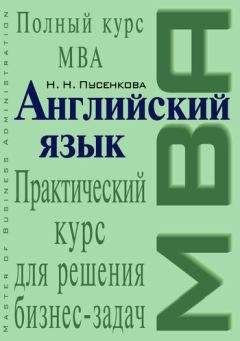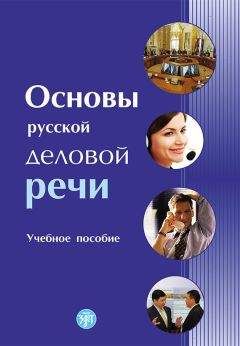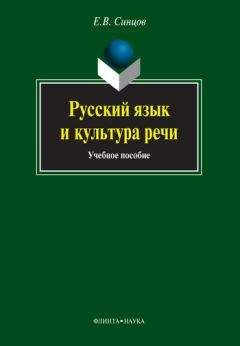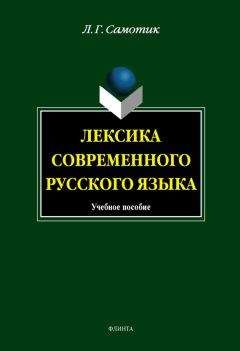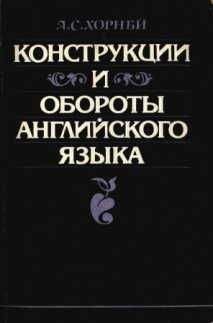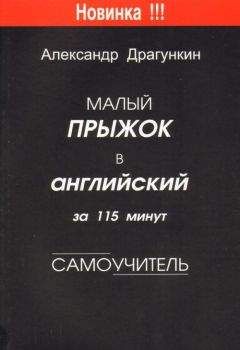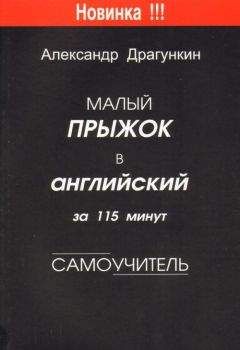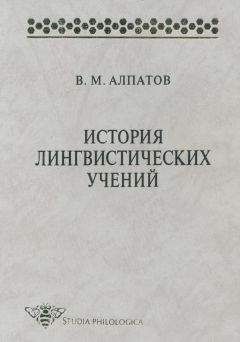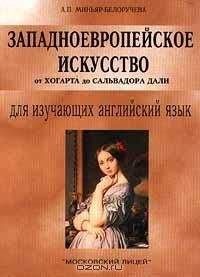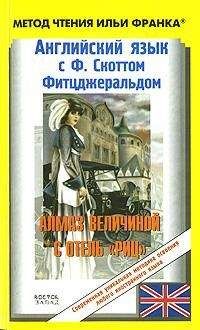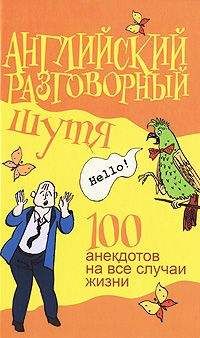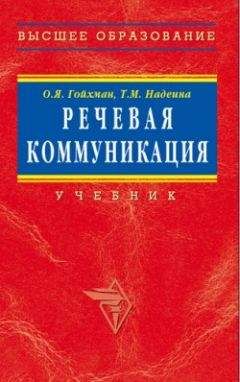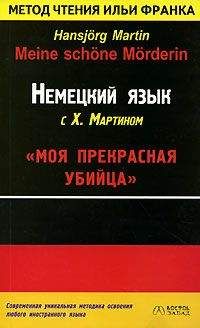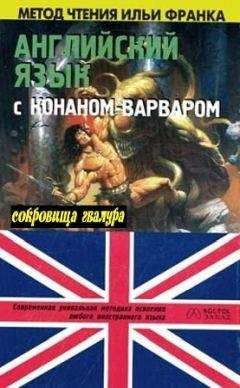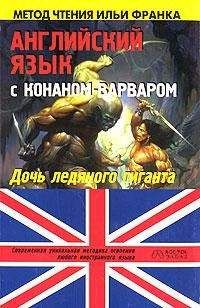А. Миньяр-Белоручева - Западноевропейское искусство от Джотто до Рембрандта
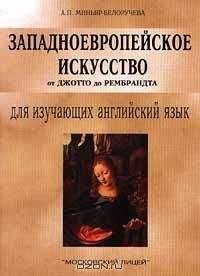
Скачивание начинается... Если скачивание не началось автоматически, пожалуйста нажмите на эту ссылку.
Жалоба
Напишите нам, и мы в срочном порядке примем меры.
Описание книги "Западноевропейское искусство от Джотто до Рембрандта"
Описание и краткое содержание "Западноевропейское искусство от Джотто до Рембрандта" читать бесплатно онлайн.
Тексты настоящего пособия охватывают пять веков западноевропейской живописи от Джотто до Рембрандта. Это дает возможность обучаемым приобрести не только лингвистические знания, усвоив обширный лексический материал, но и культурологические, поскольку последовательный хронологический переход текстов от одного художника к другому позволяет создать более или менее целостную картину развития западноевропейской искусства с XIII по XVII вв. Система упражнений направлена на усвоение лексического материала и развитие навыков устной речи.
Данная книга является первой частью цикла учебных пособий для изучающих английский язык и предназначена для студентов-искусствоведов, учащихся классических гимназий, лицеистов и всех интересующихся искусством.
Учебный центр «Московский Лицей»
пособие для изучающих английский язык
издание второе переработанное и дополненное
Москва -1999
Рецензенты:
И. И. Малинина кандидат филологических наук
Н. В. Васютина кандидат филологических наук
РЕКОМЕНДОВАНО кафедрой иностранных языков исторического факультета МГУ им. М. В. Ломоносова
Raffaello Sanzo, known as Raphael, was the third giant of the High Renaissance. In his art the High Renaissance ideal of harmony comes to its most complete expression.
Raphael was born in Urbino. First taught by his father, Giovanni Santi, a mediocre painter, Raphael worked for some time in the studio of Perugino.
In 1504 Raphael painted The Marriage of the Virgin for a church of Citta di Castello. The central group is unified around the motive of Joseph putting the ring on Mary's finger. The architecture of the distant Temple grows out of a wide piazza. The Dome of the Temple is identified with that of Heaven. The perspective of the squares in the piazza moves through the open doors of the building to the point of infinity.
About 1505 Raphael arrived in Florence and achieved immediate success. Leonardo and Michelangelo, who were working there on the murals for the council chamber in the Palazzo Vec-chio, had establislied the High Renaissance style. Raphael met the demand with ease and grace. Having absorbed Perugino's feeling for light and colour, Leonardo's composition, Michelangelo's strength and power, Raphael put his personal stamp on everything he did; he was called the «Apostle of Beauty».
During his three-year stay in Florence he painted a great number of portraits and Madonnas. The loveliest of which is the Madonna of the Meadows dated 1505. The pyramidal group was influenced by Leonardo's composition of the Madonna and Saint Anna. But Raphael's picture is simpler. The Virgin sits before an airy landscape with a lake in the distance. The Child stands in front of her. Kneeling before Him is child St John the Baptist, holding the reed Cross. The bodies and heads of the children, the Virgin and the background landscape are full of harmony. To Raphael harmony was the basic purpose of any composition.
In 1508 Julius II invited twenty-six-year-old Raphael to paint the Stanze (chambers) of the Vatican. Raphael retained the position as court painter until his early death. His ideals of figural and compositional harmony came to be recognized as the High Renaissance principles. Classical artists of succeeding centuries (Poussin in the 17-th century and Ingres in the 19-th century) turned to Raphael as the messiah of their art and doctrine. The first room frescoed by Raphael was Stanza della Segnatura. From the complex iconographic programme, it is possible to single out two frescoes on the opposite walls: they typify the Classical and Christian elements reconciled in the synthesis of the High Renaissance. The Disputa (Disputation over the Sacrament), the most complete expression of the doctrine of the Eucharist in Christian art, faces the School of Athens, an equally encyclopaedic presentation of the philosophers of pagan antiquity. In the Stanza painted afterwards, Raphael abandoned the perfect but static harmony for more dynamic compositions, which brought him to the threshold of the Baroque.
From this period dates the Sistine Madonna, so called because Saint Sixtus II kneels at the Virgin's right. The picture was intended to commemorate the death of Julius II in 1513. The saint's bearded face is a portrait of the aged pontiff. Saint Barbara, patron saint of the hour of death, looks down at his coffin, on which the papal tiara rests. The Virgin, showing the Child, walks toward the observers on the luminous clouds. In harmonizing form and movement this painting represents the pinnacle of Raphael's achievements. The Virgin and Child in their perfect beauty represent the ultimate in the High Renaissance vision of the nobility of the human countenance and form.
After the death of the warrior pope Julius II Giovanni de Medici became Roman pope. Raphael painted the portrait of Pope Leo X with Cardinals Giulio de'Medici and Luigi de'Rossi in 1517 (the fateful year when Martin Luther, whom the Pope excommunicated in 1520, nailed his theses to the door of the castle church in Wittenburg). Raphael has shown Leo X as he was in an unsparing portrait – corpulent, shrewd, pleasure-looking. Raphael endowed his subject with a new mass and volume. His analysis of the character was unexpected and profound. Raphael has shown the Pope who was incapable of holding the Roman Catholic Church together.
One of Raphael's last and greatest paintings was the Transfiguration of Christ, painted in 1517. In contrast to the traditional rendering of the subject, Raphael painted an accompanying incident as well. It was told by Matthew and Luke. When Peter, James, and John had accompanied Christ to the top of a high mountain, the remaining Apostles were unable without his presence to cast out the demons from the possessed boy. The lowei section is composed of the agitated figures of the Apostles and the youth plunged into semidarkness. The upper loop is composed of Christ, Moses, Elijah, and three Apostles. Christ and the prophets fly in the air as if lifted up by the spiritual experience. In this vision of Christ Raphael embodied his beliefs.
The great painter died on Good Friday, April 6, 1520, at the age of thirty-seven. His funeral was held in the Pantheon and the Transfiguration was placed above his bier.
To his contemporaries Raphael's death seemed the end of an era, but a closer look shows that, in a way, the High Renaissance synthesis of Classical and Christian had already started to dissolve. Inevitably, it was an unstable equilibrium. Nonetheless the great solution remained, on the walls of the Vatican, the ceiling of the Sistine Chapel, and in the churches and palaces of Florence and Rome. Leonardo, Michelangelo and Raphael left a vision of the powers of the human being and the grandeur of human imagination that had not been approached since the days of the ancient Greeks. These solutions continued to inspire artists in every century after the short-lived High Renaissance itself passed into history.
Make sure you know how to pronounce the/allowing words:
Raphael; Urbino; messiah; tiara; Wittenburg; Martin Luther; Pantheon; Eucharist; Elijah; Matthew; Luke; Ingres; luminous
NotesMarriage of the Virgin – «Обручение Марии»
Madonna of the Meadows – «Мадонна в зелени»
Disputa (Disputation over the Sacrament) – «Богословие» или «Диспута»
Schools of Athens- «Афинская школа»
Sistine Madonna – «Сикстинская Мадонна»
Transfiguration of Christ – «Преображение»
Pope Leo X with Cardinals Giulio de'Medici and Luigi de'Rossi – «Портрет папы Льва X с кардиналом Джулиано де Медичи и Луиджи де Росси»
Stanza della Segnatura – Станца делла Сеньятура «зал Подписи»
Eucharist – евхаристия, святое причастие
The Vatican – Ватикан
Good Friday – Великая пятница, пятница на страстной
неделе
TasksI. Read the text. Mark the following statements true or false
1. In Raphael's art the High Renaissance ideal of harmony comes to its most complete expression.
2. In 1505 in Rome Raphael achieved immediate success.
3. The Sistine Madonna recalls the Madonna of the Rocks.
4. Raphael, invited by Sixtus iv to paint the Stanza of the Vatican, retained the position as court painter until his death.
5. Raphael came to the threshold of the Baroque.
6. The 20-th century painters turned to Raphael as the messiah.
II. How well have you read? Can you answer the following questions?
1. Whose styles did Raphael absorb?
2. What did Raphael paint in 1504? What is depicted in this picture?
3. What was Raphael fond of painting during his three-year stay in Florence? Which one was the loveliest? How did Raphael group the figures?
4. What was the first room frescoed by Raphael? What frescoes is it possible to single out from the complex iconographic programme? What do these frescoes represent? What brought Raphael to the threshold of the Baroque style?
5. What painting represents the pinnacle of Raphael's achievements? How are the Virgin and the Child depicted? What do the saints symbolize?
6. Whose portrait did Raphael paint in 1517? What year was it? How did Raphael portray the sitter? What did he want to show?
7. What was Raphael's greatest painting? What was its subject? Was it a traditional rendering of the subject? What is the lower section composed of? What is the upper loop composed of? What did Raphael embody in this vision? Where was this painting placed?
8. What was Raphael's death to his contemporaries? What does a closer look at the short-lived High Renaissance show?
III. I. Give Russian equivalents of the following phrases
the pinnacle of the achievements; messiah of the art; to put a personal stamp on; succeeding centuries; to abandon the static harmony for dynamic compositions; a threshold of the Baroque; to endow the subject with; Good Friday; to commemorate the death of; to pass into history; patron saint of the hour of death; the fateful year; an unsparing portrait; the traditional rendering of the subject; a synthesis of Classical antiquity and Christian spirituality; an unstable equilibrium; to inspire artists in every century; the ultimate in the High Renaissance vision.
II. Give English equivalents of the following phrases:
духовный опыт; воплотить свои верования; вершинь живописных работ Высокого Ренессанса; шаткое равновесие, вдохновлять художников; Великая Пятница; традиционное изображение темы; наделить образы; судьбоносный год; почтить память; покровительница смертного часа; отказаться от статики гармонии ради динамики композиции; мессия искусства; работать над фресками; оставить печать на; объединить вокруг; беспощадный портрет; на пороге Барокко; вдохновлять художников последующих веков; синтез христианской духовности и классической античности.
III. Make up sentences of your own with the given phrases.
IV. Arrange the following in the pairs of synonyms:
a) to dissolve; to embody; beliefs; to endow; to distinguish; spiritual; profound; fateful; luminous; to abandon;
b) to bestow; deep; momentous; bright; to desert; to vanish; to manifest; doctrines; to characterise; airy.
IV. Insert the missing prepositions. Translate the text. Retell the text.
The «School… Athens» presents… an ideal architecture the chief philosophers… all periods… Greek antiquity engaged… learned argument. The figures form a circle… depth… the lofty structure, culminating… the central arch, where… the distant sky Plato, holding the «Timaeus» points… Heaven as the source… ideas… which the early forms originate, while Aristotle, holding his Ethics, indicates earth u;. the object… all observations… the upper left Socrates discusses philosophical principles… the youths… Athens… the lower left Pythagoras delineates his proportion system… a slate… pupils… the right Euclid uses another slate to demonstrate a geometric theorem.
V. Insert the article wherever necessary. Translate the text. Retell the text.
… «Disputa» begins in… Heaven. God… Father presides over… familiar Deesis with Christ enthroned, displaying his… wounds. On either side, in… floating semicircle of… cloud,… Apostles and… saints from… New Testament alternate with… prophets and… patriarchs from… Old Testament… Below…
throne of Christ,… Dove of… Holy Spirit, flanked by… child angels, with four open gospels, flies downward toward… Host. They are displayed on… altar. On either side of… alter sit… Four Fathers of… Church and… groups of… theologians from all ages of… Christianity engaged in… argumentation over… nature of… Eucharist. Among… recognizable portraits are those of… Dante, and to… left of… door, and in front of him,… Sixtus IV. Every figure is based on Raphael's fundamental spiritual principle.
VI. Here are descriptions of some of Raphael's works of art. Match them up to the given titles.
1. The painting is an encyclopaedic presentation of the philosophers of pagan antiquity.
2. The central group is unified around the motive of Joseph putting the ring on Mary's finger.
3. Raphael has shown the sitter as he was in an unsparing portrait.
4. The Virgin, showing the Child walks toward us on the luminous clouds.
5. This is the most complete expression of the doctrine of the Eucharist in Christian art.
6. In contrast to the traditional rendering of the subject, Raphael painted an accompanying incident as well.
7. The Virgin seats before a deep landscape.
a. Sistine Madonna
b. School ofAthens
c. Madonna of the Meadows
d. Transfiguration of Christ
e. Pope Leo X with Cardinals Giulio de 'Medici and Luigi de'Rossi
f. Marriage of the Virgin
g. Disputa(Disputation over the Sacrament)
VII. Translate the text into English.
Идеалы Высокого Возрождения наиболее полно воплотились в произведениях Рафаэля. Всем своим творчеством художник подчеркивал красоту и гармонию человека. Рафаэль создал возвышенный образ совершенного человека, находящегося в гармонии с окружающим миром.
В 1504 г. Рафаэль приехал во Флоренцию, где работали тогда два великих его современника — Леонардо да Винчи и Микеланджело. Многое почерпнув у них, Рафаэль создал замечательные изображения «Мадонн» и портреты. Портреты «Папы Юлиана II» и «Льва X» считаются наилучшими.
В 1508 г. папа Юлий II поручил Рафаэлю роспись станц – личных папских покоев в Ватикане. В 1509 художник приступил к работе в «Станце печати», роспись которой состоит из четырех фресок. Это – «Богословие» (спор отцов церкви о причастии), «Поэзия» (изображает величайших поэтов классической древности и итальянского Возрождения), «Правосудие» (фреска представляет основоположников светского и церковного законодательства) и «Афинская школа» (собрание философов и ученых античности). Росписи в станцах являются одной из высочайших вершин искусства Высокою Возрождения.
Подписывайтесь на наши страницы в социальных сетях.
Будьте в курсе последних книжных новинок, комментируйте, обсуждайте. Мы ждём Вас!
Похожие книги на "Западноевропейское искусство от Джотто до Рембрандта"
Книги похожие на "Западноевропейское искусство от Джотто до Рембрандта" читать онлайн или скачать бесплатно полные версии.
Мы рекомендуем Вам зарегистрироваться либо войти на сайт под своим именем.
Отзывы о "А. Миньяр-Белоручева - Западноевропейское искусство от Джотто до Рембрандта"
Отзывы читателей о книге "Западноевропейское искусство от Джотто до Рембрандта", комментарии и мнения людей о произведении.





